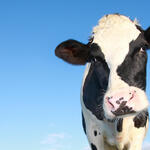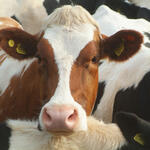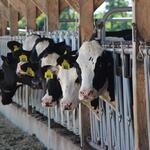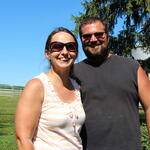- Date: 27 January 2021
- Author: Katherine Devine, Director of Business Case Development, WWF
The Possibility Is Closer than You Might Think
Many large companies have made environmental commitments to reduce embedded greenhouse gas emissions in the products they make or sell, yet are struggling to reach them. Scope 3 emissions pose a particular set of challenges—all the indirect emissions that occur both up and downstream in a company’s value chain, including from primary production, such as those emitted while producing milk on dairy farms. Within the food industry, supply chains are complex, with many ingredients going into diverse product portfolios. The dairy industry’s Net Zero Initiative¹ (NZI) has established the goal of reaching net zero GHG emissions by 2050 and has set a bold agenda to achieve this goal. Recent analysis conducted by The Markets Institute @ World Wildlife Fund—based on assumptions and data shared by stakeholders in the dairy industry—demonstrates that achieving net zero for large farms is possible with the right practices, incentives, and policies within five years. If businesses also step up to make investments and collaborate with dairy farmers in their supply chain, the potential to reach these goals can become even more tangible.
- Date: 21 January 2020
- Author: Sandra Vijn, Director of Dairy, WWF
Farmers are some of the most important stewards of our planet’s natural resources, as they work in nature every day, nurturing and growing the crops and livestock that feed us all. Because they are on the frontlines, they are vital to finding solutions to some of today’s pressing environmental challenges, including climate change.
- Date: 10 August 2016
- Author: Sandra Vijn
Last year, 9.3 million cows generated more than 200 million pounds of milk in the US. That’s a lot of nutrition, and it’s also a significant source of greenhouse gases—about 2 percent of our country’s emissions. Recognizing this fact in 2008, the dairy sector voluntarily set a goal of reducing GHG emissions from fluid milk by 25 percent by 2020, and has since undertaken several projects intended to help meet that goal.
Over the last six years, World Wildlife Fund has worked with the Innovation Center for US Dairy, dairy farmers, consumer brands, and others to develop a digital tool called Farm Smart® to help dairy farmers measure, shrink, and share their GHG and energy footprints.
Now, the Farm Smart tool will be incorporated into the FARM Environmental Stewardship module that is being added to the existing FARM Animal Care and FARM Antibiotic Residue Prevention modules, managed by National Milk Producers Federation (NMPF). The FARM Environmental Stewardship module will be available to all 43,000 US dairy farmers on January 1, 2017.
By entering their production metrics into a digital survey, farmers can use the FARM Environmental Stewardship module to see how their herd size; feed, and energy use; manure systems; and other variables affect their environmental and economic performance. For dairy buyers and brands that have established climate change goals of their own, the module can help them track of emissions and energy use within their supply chains. It can also be used to identify potential efficiency gains and cost savings. It can help find ways to produce more milk with less resources.
Why is WWF involved? We are dedicated to driving sustainable food systems to conserve nature and feed the planet. That means using fewer resources to produce more food on the current amount of land, and protecting natural habitats, keeping oceans, rivers, and lakes clean, and curbing climate change. These issues are important for the dairy industry: Beyond greenhouse gas emissions, dairy cows produce manure, which needs to be properly managed to protect waterways, and use feed, which should be produced in ways that conserve soils and water, and doesn’t lead to conversion of ecologically important areas such as prairies, wetlands, and forests.
Though climate change will affect everyone on the planet, farmers are on the front lines. It threatens them directly in the form of erratic weather and indirectly in the form of volatile prices for energy, feed, and other inputs.
It’s also a critical issue of trust and transparency. Consumers increasingly want to know where their food comes from and how it was produced. The FARM Environmental Stewardship module creates a platform for uniform reporting of GHG emissions and energy use, and in addition to the FARM Animal Care and FARM Antiobiotic Residue Prevention Modules, will give customers and consumers a more comprehensive and up-to-date view of what it takes to produce a gallon of milk.
As challenging as it is for a single company to reduce its energy use and GHG emissions, it’s even more difficult for an industry of 43,000 businesses—as well as their customers down the supply chain—to act collectively. That’s why this is so significant: it gives every farm a consistent means to measure and manage their emissions. It also sets an example for other industries looking to take similar actions.
It’s now up to us—WWF, the Innovation Center, and NMPF, among others—to ensure it’s used as widely as possible. Given how valuable it is for all involved, there’s good reason to be optimistic.
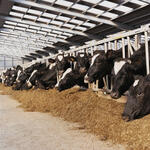
Wrangling Nutrients from Livestock Manure: A Triple-Win for Farmers, the Economy and Our Environment
- Date: 30 December 2015
- Author: Marlena White, WWF
Using manure to grow crops has been a bedrock of agriculture for thousands of years. In the US, more than nine billion animals generate over a billion tons of excrement annually. Improperly handled and managed manure can lead to the pollution of drinking water, groundwater and aquatic ecosystems. Indeed, nitrogen and phosphorous—two critical nutrients in animal waste and crop fertilizer—end up in the Mississippi River watershed and wash into the Gulf of Mexico. Instead of feeding crops on land, they feed microbes in the water, which thrive in the summer heat and create low-oxygen “dead zones” where fish can’t survive.
- Date: 09 December 2015
- Author: Sandra Vijn, WWF; Chad Frahm, Innovation Center for U.S. Dairy
A place of great abundance is known as the “land of milk and honey.” And yet even in our world of increasingly constrained resources, demand for dairy is growing. Keeping the world’s most popular foods on supermarket shelves while safeguarding the planet isn’t impossible. It will just take hard work and innovation, much of which is already happening today.
The world needs to produce 70 percent more food to feed our growing population by 2050, with an expected 58% increase in demand for dairy. To meet these needs, climate-smart agriculture – the science and technology farmers need to mitigate and adapt to a changing climate – has taken a prominent role in the U.N. climate change conference, or COP21. In addition to an “Agriculture Action Day” there are multiple forums addressing land use, nutrition, resilience, soil health, food security, and the needs of farmers. While it is widely accepted that food and agricultural systems must increase production to feed the growing global population, we must do so in ways that optimize the use of scarce resources within the carrying capacity of the planet, that protect and enhance ecosystems, and that are resilient to the impacts of climate change.
- Date: 30 December 2014
Each year at the Vander Haak Dairy, 500 cows produce 14 million pounds of milk. An anaerobic digester — the first in Washington state, installed in 2004 — converts their manure, plus food waste from nearby food processors, into energy and other saleable products.
- Date: 16 December 2014
With a family history in farming that spans more than 90 years, the McCartys knew a major change was needed to brace for volatile milk pricing and water scarcity. With ingenuity and a creative approach, the McCartys run three full-scale dairy operations producing 60,000 gallons of milk each day, as well as a condensed milk processing plant in partnership with The Dannon Company, Inc., that extracts 39,000 gallons of water from the milk before it is transported each day.
- Date: 02 December 2014
Making sustainability a priority, the Marshik Dairy -- a fifth-generation family farm -- implemented a new, technologically advanced and energy efficient barn design on their 155-cow dairy. The new design included robotic milking facilities, energy efficient lighting and ventilation, and renewable wind and solar power.
- Date: 18 November 2014
Traditionally, anaerobic digester systems have not been practical on small dairy farms, but this didn’t stop Sensenig Dairy, a 100-cow farm, from pursuing its goal. The Sensenig teamed up with the local community to collect enough waste to produce 1,401,600 kilowatt hours of electricity per year from ‘trash’ that would otherwise end up in a landfill.
- Date: 04 November 2014
With a sustainability mindset from day one, Joseph Gallo Farms aims to maximize the operational efficiencies of its business while working toward a goal of zero emissions and zero waste.
Joseph Gallo founded his namesake business more than 65 years ago, pioneering the art of sustainable cheesemaking.

